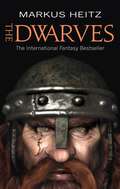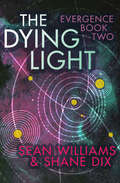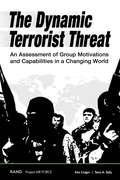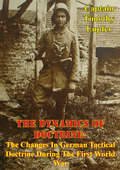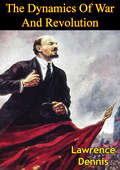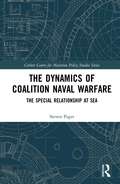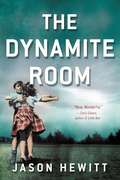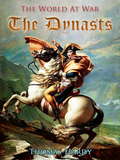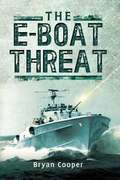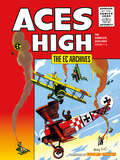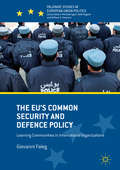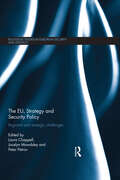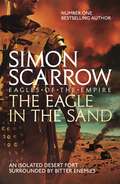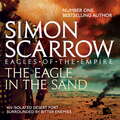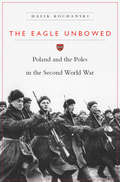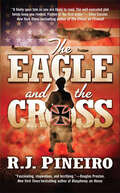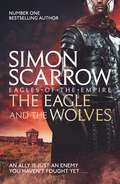- Table View
- List View
The Dwarves: Book 1 (Dwarves #1)
by Markus HeitzFor countless millennia, no man or beast has ever succeeded in breaching the stone gateway into Girdlegard. Until now . . .Abandoned as a child, Tungdil the blacksmith is the only dwarf in a kingdom of men. But when he is sent out into the world to deliver a message and reacquaint himself with his people, the young foundling finds himself thrust into a battle for which he has not been trained. Not only his own safety, but the life of every man, woman and child in Girdlegard depends upon his ability to embrace his heritage. Although he has many unanswered questions, Tungdil is certain of one thing: no matter where he was raised, he is a true dwarf.And no one has ever questioned the courage of the Dwarves.The international bestselling fantasy epic now available in English for the first time.Other books by Markus Heitz:War of the DwarvesThe Revenge of the DwarvesThe Fate of the DwarvesThe Triumph of the DwarvesRighteous FuryDevastating HateDark PathsRaging StormAera book's one to ten
The Dyess Story - The Eye-Witness Account Of The DEATH MARCH FROM BATAAN [Illustrated Edition]
by Lt.-Colonel William Dyess[Illustrated with over 30 photos of the author, his unit, escape, his kit etc.]As General MacArthur sailed away from the Philippines vowing to return, he left behind him many American soldiers that had been swept up by the victorious Japanese tide of invasion. One such man was Lt.-Colonel William Edwin 'Ed' Dyess, he and his unit of the 21st Pursuit squadron flew their obsolete P-40 Warhawks against the superior Japanese fighters until no more planes remained. Undaunted he fought on as an infantryman before his eventual capture by the Japanese his deeds of selfless bravery were legendary, including giving his own plane to a fellow aviator so he could fly to safety. Dyess and his brave men deserved a better fate than that which awaited them at the hands of their Japanese captors on the infamous Bataan Death March. Driven north from Bataan, the American and Philippino prisoners were beaten, starved and prodded at the tip of the bayonet toward prison camps that had been callously unprovided with the basic means of existence. In the only successful mass prison escape, Dyess along with his men broke out of their prison camp and made contact with resistance groups. After a time waging further Guerilla operations, Dyess and two other American servicemen were evacuated by submarine to Australia. As Dyess recuperated the American Government knowing the effect that the truth of the atrocities committed by the Japanese would galvanize public opinion allowed the release of his story via the Chicago Tribune. The story created a huge storm of outrage directed at the Japanese and of respect and admiration for Dyess and his fellow soldiers who had endured so much on their behalf. Dyess returned to active service as soon as was possible but tragically died in an airplane accident in 1943, a hero to his men and country.A tragically vivid and gruelling account of one of the most heroic escape stories yet told.
The Dying Light (Evergence #2)
by Sean Williams Shane DixMorgan Roche is a renegade, fleeing the agents she used to work for in the Commonwealth of Empires. Her quest to understand Adoni Cane has led her to a terrible truth. He is one of a breed of genetically enhanced warriors that once terrorized the galaxy. And there might be more of them, waking up to begin fighting anew. AN INTERSTELLAR TRAP: A whole solar system has disappeared, wiped from the universe in an attempt to snare just one super-soldier like Cane. In an attempt to come to grips with her enemy, Morgan Roche and The Box travel willingly into the trap, but find themselves ensnared in ever-thicker tangles of deception and intrigue. Who is The Box, and is what its agenda, really? The answer will rock Roche&’s world right down to the foundations. &“I'm not sure what an Evergence is, but finding out promises to provide hours of fun.&” --Locus &“Genre-savvy and capably written, full of adventure and Asimovian imperial vistas&” --Asimov's &“Full of adventure of Asimovian imperial vistas. Delivers tons of action…Offers wide-screen baroque plotting never out-of-control. With echoes of vintage Jack Williamson and Poul Anderson, as well as Niven, Asimov, and Vinge, Williams and Dix proudly continue a vital tradition in SF.&” --Analog Nominated for the Aurealis Award
The Dynamic Terrorist Threat: An Assessment of Group Motivations and Capabilities in a Changing World
by Cheryl Y. Marcum Sara A. Daly Kim Cragin M. Rebecca Kilburn Susan S. Everingham Jill HoubeAs the war on terrorism wages on, our nation's policymakers will continue to face the challenge of assessing threats that various terrorist groups pose to the U.S. homeland and our interests abroad. As part of the RAND Corporation's yearlong "Thinking Strategically About Combating Terrorism" project, the authors of this report develop a way to assess and analyze the danger posed by various terrorist organizations around the world. The very nature of terrorism creates a difficulty in predicting new and emerging threats; however, by establishing these types of parameters, the report creates a fresh foundation of threat analysis on which future counterterrorism strategy may build.
The Dynamics Of Doctrine: The Changes In German Tactical Doctrine During The First World War [Illustrated Edition]
by Captain Timothy Lupfer[Includes 4 maps and 3 figures]This latest Leavenworth Paper is a case study in the wartime evolution of tactical doctrine. Previous publications of the Combat Studies Institute have examined the peacetime development of doctrine and have increased our knowledge of how doctrine has been applied. With the publication of Captain Lupfer's study, "The Dynamics of Doctrine," the Combat Studies Institute adds another dimension to the history of the processes of doctrinal change.Besides providing a summary of German infantry tactics of the First World War, this study offers insights into the crucial role of leadership in facilitating doctrinal change during battle. It once again reminds us that success in war demands extensive and vigorous training calculated to insure that field commanders understand and apply sound tactical Principles as guidelines for action and not as a substitute for good judgment. It points out the need for a timely effort in collecting and evaluating doctrinal lessons from battlefield experience.Finally, this study reminds us of yet another fundamental lesson from the past-that tendencies toward accepting the battlefield as a routine can be a deadly error. Altering previously accepted tactics in the middle of a struggle, as the author points out, is a very urgent and serious matter. As members of the Profession of Arms, we must be sensitive to the demands of change, visionary in our examination of their implications, and creative in our adaptation of combat organizations, tactics, and techniques.
The Dynamics Of War And Revolution: A Study Of The Hidden Economic Origins Of Conflict
by Lawrence DennisLawrence Dennis presents his analysis of the political and economic situation that led to the Second World War. He introduces his theories on Dynamism and the decline of Capitalism throughout the world which he believes will be accelerated by world war. Originally published in 1940.--Print Ed.
The Dynamics of Coalition Naval Warfare: The Special Relationship at Sea (Corbett Centre for Maritime Policy Studies Series)
by Steven PagetThis book examines the dynamics of coalition naval operations. Since the end of the Second World War, few nations possess the capacity for large scale, sustained and independent naval operations; and even those that do, such as the USA, often find it economically, militarily and politically expedient to act multilaterally. As such, coalition naval operations increasingly became the norm throughout the twentieth-century, and there is little sign of this abating in the twenty-first. Multinational operations provide a number of benefits, but they also present a number of challenges. Examining the dynamics of coalition operations involving the Royal Navy (RN), Royal Australian Navy (RAN) and the United States Navy (USN) during the Korean War, Vietnam War and the Iraq War, this book provides a broad overview of naval interoperability between the three navies. Using the naval gunfire support (NGS) capability as a lens through which to analyse operations, the study explores a diverse range of issues, including: command and control, communications, equipment standardisation, intelligence, logistics, planning, rules of engagement, tactics, techniques and procedures and training. Approaching the subject through both historical and contemporary perspectives not only provides a unique assessment of the variation in the effectiveness of interoperability over time, but also offers a platform for better understanding and enhancing the performance of future coalition naval operations. Based on extensive archival research in Australia, the UK and the US, as well as wide-ranging interviews, this book sheds new light on the dynamics of conducting coalition operations. This book will be of great interest to students of naval history, strategic studies, sea power, maritime security, military studies, and IR in general.
The Dynamics of Coercion: American Foreign Policy and the Limits of Military Might
by Matthew Waxman Daniel BymanThis book examines how the United States uses limited military force and other means to influence adversaries and potential adversaries. It reviews when limited force can and cannot work and examines a range of current challenges, including those of guerrilla groups or minor powers armed with nuclear, chemical, or biological weapons. It also looks at the complications arising from domestic politics and the difficulties of using force in an alliance.
The Dynamics of Military Revolution 1300-2050
by Williamson Murray Macgregor KnoxThe Dynamics of Military Revolution aims to bridge a major gap in the emerging literature on revolutions in military affairs, suggesting that there have been two very different phenomena at work over the past centuries: 'military revolutions', which are driven by vast social and political changes; and 'revolutions in military affairs', which military institutions have directed, although usually with great difficulty and ambiguous results. By providing both a conceptual framework and a historical context for thinking about revolutionary changes in military affairs, the work establishes a baseline for understanding the patterns of change, innovation, and adaptation that have marked war in the Western World since the thirteenth century - beginning with Edward III's revolutionary changes in medieval warfare, through the development of modern Western military institutions in seventeenth-century France, to the cataclysmic changes of the First World War and the German Blitzkrieg victories of 1940. This history provides a guide for thinking about military revolutions in the coming century, which are as inevitable as they are difficult to predict.
The Dynamics of the Armed Struggle
by J. Bowyer BellThis is an analysis of one of the most prevalent forms of political violence at the end of the millennium. The author has been shot at, kidnapped, expelled and questioned in wars from Central America to Northern Ireland. The book reflects his access to the cultures of political violence.
The Dynamite Room: A Novel
by Jason HewittIt was all her doing. She had cried wolf, and the wolf had come. It's July 1940, and eleven-year-old Lydia has just run away from life as a child evacuee in Wales. She arrives in her English village, gas mask in tow, only to find it abandoned. Her family's house is shuttered and empty, the windows covered by black-out blinds--but Lydia settles in, determined to wait there until they return. Late that night he comes: a wounded soldier, gun in hand, heralding a full-blown German invasion. There are, the man explains, certain rules that Lydia must now follow. He says he won't hurt Lydia, but she cannot leave the house.As the unlikely pair coexists in the claustrophobic confines of the house, each becomes dependent on the other for survival. But when Lydia tries to uncover what brought the soldier to her door, she realizes that he knows more than he should about her family--and that he's plotting something for them both.Eerie, gripping, and piercingly sad, The Dynamite Room brings a strikingly original and contemporary resonance to the great tradition of war classics. It shrinks the global theater of history's most devastating war to a game of cat and mouse played out in a single house--resulting in a moving portrait of war and how it affects soldiers and citizens alike.
The Dynasts
by Thomas Hardy"The Dynasts" is an English-language drama in verse by Thomas Hardy. Hardy himself described this work as "an epic-drama of the war with Napoleon, in three parts, nineteen acts and one hundred and thirty scenes". Not counting the Forescene and the Afterscene, the exact total number of scenes is 131. The three parts were published in 1904, 1906 and 1908. Because of the ambition and scale of the work, Hardy acknowledged that The Dynasts was not a work that could be conventionally staged in the theatre, and described the work as "the longest English drama in existence". Scholars have noted that Hardy remembered war stories of the veterans of the Napoleonic wars in his youth, and used them as partial inspiration for writing The Dynasts many years later in his own old age. In addition, Hardy was a distant relative of Captain Thomas Hardy, who had served with Admiral Horatio Nelson at Trafalgar. Hardy consulted a number of histories and also visited Waterloo, Belgium, as part of his research. George Orwell wrote that Hardy had "set free his genius" by writing this drama and thought its main appeal was "in the grandiose and rather evil vision of armies marching and counter-marching through the mists, and men dying by hundreds of thousands in the Russian snows, and all for absolutely nothing."
The E-Boat Threat
by Bryan CooperOne of the major lessons of World War II was the importance of coastal waters. It was not widely recognised beforehand just how vital the control of such waters would become, both in defending essential convoys as well as attacking those of the enemy, and in paving the way for amphibious landings.While land based aircraft could carry out offshore operations by day and destroyers and cruisers patrolled deeper waters, the ideal craft for use in coastal waters were motor boats armed with torpedoes and light guns. But with the exception of Italy, none of the major powers had more than a handful of these boats operational at the outbreak of war.From a small beginning, large fleets of highly maneuverable motor torpedo boats were built up, particularly by Britain, Germany and the USA. They operated mainly at night, because they were small enough to penetrate minefields and creep unseen to an enemy's coastline and fast enough to escape after firing their torpedoes. They fought in every major theatre of war, but the first real threat came in the North Sea and English Channel from German E-boats, crossing to attack Britain's vital convoys. Ranged against them in the 'battle of the little ships' were British MTBs and MGBs and, later, American PT boats. They often fought hand to hand at closer quarters than any other kind of warship in a unique conflict that lasted right to the end of the war.The E-boat Threat describes the development of these deadly little craft, the training of their crews who were usually volunteers and the gradual evolution of tactics in the light of wartime experience. Methods of defence are also related, which included the use of aircraft and destroyers as well as motor gunboats, sometimes acting under a unified command.
The EC Archives: Aces High
by Carl Wessler Irv WersteinExperience the dangers and thrills of aerial combat with Aces High! This handsome volume collects issues #1-5 of the classic war comic, including unforgettable stories from the all-star artistic lineup of George Evans, Wally Wood, Jack Davis, Bernie Krigstein, Irv Werstein, Carl Wessler, and Jack Oleck. • Aces High issues #1-5, the complete series, in full color! • Features stories drawn by all-star comic artists George Evans, Wally Wood, Jack Davis, and Bernie Krigstein! • Dark Horse reprints the infamous comic series, including all the original ads, text pieces, and letters!
The EU and the European Security Order: Interfacing Security Actors (Contemporary Security Studies)
by Rikard BengtssonThis book attempts to conceptualise EU action in the field of regional security. Drawing on constructivist theory, the framework of the book focuses on the meeting - or 'interface' - of actors, a situation reflecting the mutual construction of self, other and situation. The analytical framework applied here to European security politics is potentially open-ended as the theoretical logic that informs the framework is general and abstract in character, and not limited to state actors in an international setting. The empirical aim of this book is to further our understanding of the EU as a security actor in a regional perspective. The book thus links International Relations scholarship with that of EU studies. By analyzing a number of different interfaces (such as with Russia, the US, and other states), we can learn more about the circumstances and preconditions and with what resources and power the EU acts in a regional security setting. This book will be of great interest to students of European security, EU policy, IR theory and security studies in general. Rikard Bengtsson is Assistant Professor of Political Science at Lund University, Sweden. He has a PhD in Political Science, from Lund University, Sweden.
The EU's Common Security and Defence Policy
by Giovanni FalegThis book accounts for transformations in the EU's Common Security and Defence Policy (CSDP)during fifteen years of operations (2001-2016), and argues that the EU evolved into a softer and more civilian security provider, rather than a military one. This learning process was driven by transnational communities of experts and practitioners, which acted as engines of change. Giovanni Faleg analyses two innovative concepts introduced in the EU security discourse since the late 1990s: security sector reform (SSR) and civilian crisis management (CCM). Both stem from a new understanding of security, involving the development of non-military approaches and a comprehensive approach to crisis management. However, the implementation of the two policy frameworks by the EU led to very different outcomes. The book explains this variation by exploring the pathways by which ideas turn into policies, and by comparing the transformational power of epistemic communities and communities of practice.
The EU, Strategy and Security Policy: Regional and Strategic Challenges (Routledge Studies in European Security and Strategy)
by Laura Chappell, Jocelyn Mawdsley and Petar PetrovThis edited collection is a timely and in-depth analysis of the EU’s efforts to bring coherency and strategy to its security policy actions. Despite a special European Council summit in December 2013 on defence, it is generally acknowledged that fifteen years since its inception the EU’s Common Security and Defence Policy (CSDP) has yet to acquire a clear sense of purpose. This book investigates those areas where the EU has established actorness in the security and defence field and asks whether they might constitute the elements of an emergent more coherent EU strategy on security. Taking a critical view, the contributors map the EU’s strategic vision(s) across particular key regions where the EU has been active as a security actor, the strategic challenges that it has pinpointed alongside the opportunities and barriers posed by a multiplicity of actors, interests and priorities identified by both member states and EU actors. By doing this we demonstrate where gaps in strategic thinking lie, where the EU has been unable to achieve its aims, and offer recommendations concerning the EU’s future strategic direction. This book will be of much interest to students of European security, EU policy, strategic studies and IR in general.
The EU, the UN and Collective Security: Making Multilateralism Effective (Contemporary Security Studies)
by Krause Joachim Ronzitti NatalinoThis book examines the effectiveness of multilateralism in ensuring collective security and, in particular, the EU’s role in this process. In 1992, shortly after the end of the Cold War, a Security Council Summit in New York reaffirmed the salience of the system of collective security and stated the determination of the Heads of State to maintain it as the prime international instrument for preserving peace. Twenty years later, however, the record of collective security as well as of multilateralism has not been very encouraging. The system of collective security, as enshrined in the United Nations (UN) Charter, failed repeatedly to accomplish its mandate in the 1990s and has led to controversial debates in the United States and Europe that reached a climax during the Iraq crisis in 2002/03. The volume draws upon both theoretical and empirical research to answer the following core questions: What are the reasons that have made multilateralism either effective or ineffective in the field of peacekeeping, peace preservation and peacebuilding? How can multilateralism be made more effective? How can attempts made by Europe to render UN multilateralism in the security area more efficient be assessed? This book will be of much interest to students of peacebuilding/peacekeeping, EU policy, the UN, security studies and IR in general.
The EU’s Strategic Dilemma in the Ukraine War: Sanctions, Military Aid, and the Struggle for Coherence in Foreign Policy (SpringerBriefs in International Relations)
by Viktor JakupecAs the war in Ukraine enters its fourth year, this book critically examines the strategies employed by the European Union (EU) and the United States (US) in their support of Ukraine. It examines how sanctions, military aid, and diplomacy have shaped the conflict and considers whether these efforts are falling short. Through political, economic, and strategic analysis, it explores the EU’s internal divisions, the changing role of US leadership under a second Trump administration, and the increasing risk of Ukraine being marginalised in global negotiations. The author questions whether the EU’s reliance on sanctions and fragmented military support has weakened its own position more than that of Russia. Providing a realist perspective on the war’s broader geopolitical consequences and the uncertain future of European security, this book challenges dominant narratives.
The Eagle In The Sand (Eagles of the Empire #7)
by Simon ScarrowIF YOU DON'T KNOW SIMON SCARROW, YOU DON'T KNOW ROME!THE EAGLE IN THE SAND is the action-packed seventh novel in Simon Scarrow's bestselling Eagles of the Empire series. Essential reading for fans of Bernard Cornwell. 'Scarrow's [novels] rank with the best' IndependentJudaea in AD 46. Roman centurions Cato and Macro have been posted to Judaea for a 'hearts and minds' operation. The Empire needs to win over the locals after some of their religious figures have started revolts - and since the Romans crucified the last charismatic Judaean leader, the natives' rebellions have become bolder.Not only are these small villages causing trouble, but there are also thousands of Parthians eager to fight Rome. With the threat of suicide attacks and even all-out war, Cato and Macro have their peace-keeping work cut out...
The Eagle In The Sand (Eagles of the Empire #7)
by Simon ScarrowIF YOU DON'T KNOW SIMON SCARROW, YOU DON'T KNOW ROME!THE EAGLE IN THE SAND is the action-packed seventh novel in Simon Scarrow's bestselling Eagles of the Empire series. Essential reading for fans of Bernard Cornwell. 'Scarrow's [novels] rank with the best' IndependentJudaea in AD 46. Roman centurions Cato and Macro have been posted to Judaea for a 'hearts and minds' operation. The Empire needs to win over the locals after some of their religious figures have started revolts - and since the Romans crucified the last charismatic Judaean leader, the natives' rebellions have become bolder.Not only are these small villages causing trouble, but there are also thousands of Parthians eager to fight Rome. With the threat of suicide attacks and even all-out war, Cato and Macro have their peace-keeping work cut out...
The Eagle In The Sand: Cato & Macro: Book 7 (Eagle #27)
by Simon ScarrowIF YOU DON'T KNOW SIMON SCARROW, YOU DON'T KNOW ROME!THE EAGLE IN THE SAND is the action-packed seventh novel in Simon Scarrow's bestselling Eagles of the Empire series. Essential reading for fans of Bernard Cornwell. 'Scarrow's [novels] rank with the best' IndependentJudaea in AD 46. Roman centurions Cato and Macro have been posted to Judaea for a 'hearts and minds' operation. The Empire needs to win over the locals after some of their religious figures have started revolts - and since the Romans crucified the last charismatic Judaean leader, the natives' rebellions have become bolder.Not only are these small villages causing trouble, but there are also thousands of Parthians eager to fight Rome. With the threat of suicide attacks and even all-out war, Cato and Macro have their peace-keeping work cut out...(P)2012 Headline Publishing Group Ltd
The Eagle Unbowed: Poland and the Poles in the Second World War
by Halik KochanskiWorld War II gripped Poland as it did no other country. Invaded by Germany and the USSR, it was occupied from the first day of war to the last, and then endured 44 years behind the Iron Curtain while its wartime partners celebrated their freedom. The Eagle Unbowed tells, for the first time, the story of Poland’s war in its entirety and complexity.
The Eagle and the Cross
by R. J. PineiroThe Bloodiest Battle in World HistoryAt Stalingrad 3.2 million men and women will die. Those fighting include:Captain Jack Towers of the US Army Air Corps—who will learn duty, courage and . . . love.Lieutenant Erich Steinhoff, the Luftwaffe ace—who will watch the city be blanketed by fire.Colonel Aleksandrovich Krasilov, the Red Air Force star—who will battle Goering's Luftwaffe while searching for his missing wife.Dr. Zoya Krasilov, the Colonel's wife—who, captured when her hospital is overrun, will escape a Nazi death camp to join the Resistance and become a Stalingrad sniper.Lieutenant Natalya Makarova, of USSR's Night Witches—who will fly night sorties over Germany in WWI biplanes . . . and vie for Jack Towers' love.At the Publisher's request, this title is being sold without Digital Rights Management Software (DRM) applied.
The Eagle and the Wolves (Eagles of the Empire #4)
by Simon ScarrowIF YOU DON'T KNOW SIMON SCARROW, YOU DON'T KNOW ROME!THE EAGLE AND THE WOLVES is the gripping fourth novel in Simon Scarrow's bestselling Eagles of the Empire series. Perfect for fans of Bernard Cornwell and Conn Iggulden. 'A new book in Simon Scarrow's long-running series about the Roman army is always a joy' The TimesBritannia, AD 44. Occupation is never easy. The enemy is butchering their supply convoys, their garrison town is starving and the truce with the locals is uneasy at best. Young Cato, newly promoted, and veteran centurion Macro are ordered to train the Wolves and the Boars, two cohorts of barbarian Britons, and introduce them to the brutal drills of the Roman Imperial Army. Macro is confident they'll win the natives over, but Cato worries about putting weapons into the hands of potential rebels.Ultimately, only one thing matters: is there a difference between the enemy at their gates, and the allies in their own camp?
